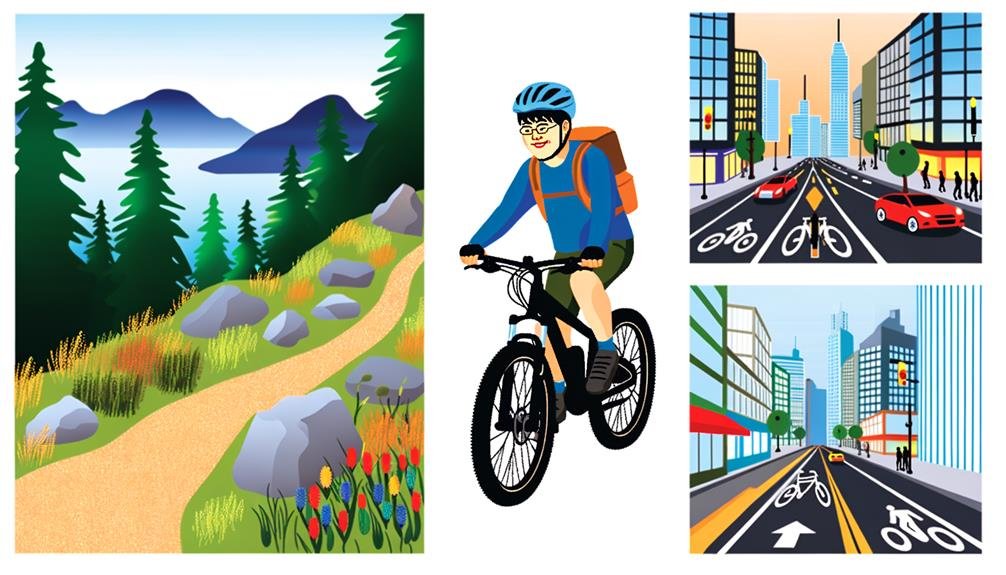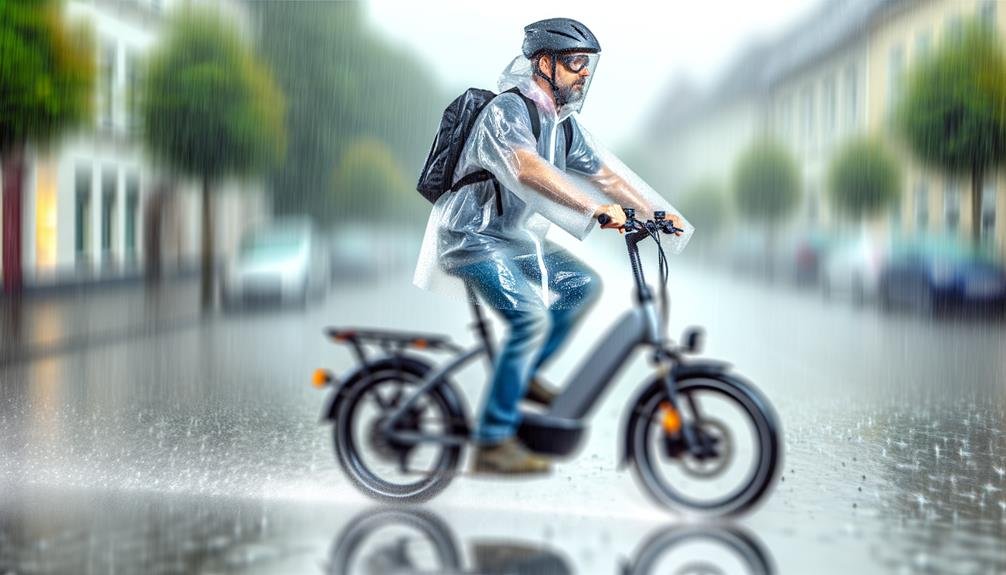Charles Miller is a veteran bike enthusiast with over 12 years of experience dealing with bikes as a mechanic. Despite immense love and expertise for...
Like a key unlocking endless possibilities, our electric bikes offer us a whole new world of exploration. We can take them on city streets, mountain trails, and even some state and national parks.
However, there are a few considerations we need to keep in mind before we hit the road. For instance, not all places are e-bike friendly due to certain laws and regulations. So, where exactly can we take our e-bikes without hitting a roadblock?
Let's uncover this together, as it's not just about the destination, but the journey itself that makes the ride worthwhile.
Key Takeaways
- There are several places in Texas where you can ride electric bikes, including the Mission Reach trail in San Antonio, Ann and Roy Butler Trail in Austin, and Brays Bayou Greenway Trail in Houston.
- E-bike usage is permitted almost anywhere bicycles are allowed in Texas, including multi-use trails.
- E-bike riders should follow trail etiquette, prioritize safety, and be aware of specific regulations.
- E-bikes are permitted on specific trails in state and national parks in Texas, and the National Park Service has opened trails to e-bikes in US national parks.
Exploring City Streets on E-Bike
Navigating through the bustling city streets on an electric bike, we can explore trails like the Mission Reach in San Antonio, the Ann and Roy Butler Hike and Bike Trail in Austin, or the Brays Bayou Greenway Trail in Houston, all offering unique views and experiences of Texas's urban landscapes.
Riding your e-bike on the 16-mile Mission Reach trail will take you past historic missions and through the natural beauty of San Antonio.
In Austin, exploring city streets on e-bike leads us to the 10-mile loop of the Ann and Roy Butler Trail. This route surrounds Lady Bird Lake, home to over 230 species of animals, and offers easy access with multiple parking options for e-bike users.
Houston's Brays Bayou Greenway Trail is a treat for those of us who ride our e-bikes at all hours, as it's open 24/7/365. Spanning over 30 miles, this trail connects to the city's best sights, parks, and attractions like the Houston Zoo and Museum District.
In Texas, we're lucky to enjoy legal e-bike usage almost anywhere bicycles are permitted, including these multi-use trails. Also, Austin's subsidy programs can provide financial incentives to boost your e-biking experience.
Riding E-Bikes on Mountain Trails
Taking your e-bike on mountain trails requires a unique set of manners and precautions. Let's discuss trail etiquette, covering points such as right of way, speed control, and mindful interaction with other trail users.
We'll also touch on safety measures specifically designed for e-bikers to ensure a secure and enjoyable ride.
Trail Etiquette for E-Bikers
When exploring mountain trails on our e-bikes, it's crucial to practice respect and courtesy towards other trail users such as hikers and runners. As responsible e-bike riders, we must remember to uphold trail etiquette for e-bikers.
This includes:
- Yielding to non-motorized trail users and announcing our presence when passing.
- Staying on designated trails, particularly avoiding areas marked as bike-free zones, to minimize our environmental impact.
- Prioritizing safety by wearing appropriate gear, like helmets and reflective clothing, and by respecting speed limits.
- Keeping informed about specific trail regulations and e-bike access rules in our riding area.
E-Bike Safety Precautions
Safety should always be our first priority while riding e-bikes on mountain trails. This starts with protecting ourselves by wearing a helmet and suitable safety gear.
As part of our e-bike safety precautions, we should always follow trail regulations and guidelines specific for electric bicycle usage. This not only ensures our safety but also respects other trail users.
We need to exercise caution and be prepared for changing terrain and weather conditions. It's crucial to ride an electric bike responsibly, yielding when necessary and using appropriate passing etiquette.
Lastly, we show our commitment to environmental preservation by staying on designated trails and avoiding areas where e-bikes are prohibited.
Together, we can ensure a safe and enjoyable e-biking experience.
E-Bike Regulations and Laws

Understanding the regulations and laws governing e-bikes is crucial before taking your ride out, and these rules can vary from state to state, and even city to city. For instance, in Texas, e-bike regulations and laws follow the 3-class system, allowing e-bike use anywhere traditional bikes are allowed, including multi-use trails. But, remember to strap on your helmet as that's mandatory.
To illustrate, let's look at four key regulations:
- In Austin, TX, there's a subsidy program for e-bike purchases, so keep an eye out for these incentives.
- E-bikes are permitted on motorized trails, open OHV areas, and BLM-managed public lands, but specific regulations and authorization are required for non-motorized trails.
- In December 2020, the BLM amended OHV regulations allowing certain e-bike classes on non-motorized roads and trails. However, the BLM office retains the authority to identify non-motorized trails for e-bike use.
- E-bikes, defined as bicycles with small electric motors, can be ridden in most places traditional bikes can, except in specific non-motorized areas.
E-Bikes in State and National Parks
Having navigated the intricacies of e-bike regulations, let's now explore the accessibility of e-bikes in state and national parks, a thrilling prospect for nature-loving cyclists.
E-bikes are allowed on specific trails in numerous state and national parks. For instance, in Texas, you can ride your e-bike on the Mission Reach Trail in San Antonio, the Ann and Roy Butler Hike and Bike Trail in Austin, and the Brays Bayou Greenway Trail in Houston. In these parks, e-bikes are permitted anywhere bicycles are, making multi-use trails accessible to e-bike riders.
The National Park Service has opened trails to e-bikes in US national parks, and about 60,000 miles of national forest and grasslands trails in the US Forest Service lands. This move has greatly increased the number of E-Bike Trails and expanded the possibilities for us as e-bike enthusiasts.
Keep in mind, though, that we need to follow all applicable laws and regulations when riding our e-bikes. And don't forget your helmet, a requirement for riders in Texas. With these measures, we can enjoy the beauty of our state and national parks, responsibly and safely.
Safety Measures for E-Bike Riders

On our journey as e-bike enthusiasts, we mustn't overlook the importance of adhering to safety measures. These measures include not just wearing a helmet and obeying traffic laws, but also communicating our intentions to other road users, performing regular bike maintenance, and adjusting our riding style to the weather conditions.
As part of our community, we've gathered four key safety measures for e-bike riders that we must all incorporate into every ride.
- Wearing a helmet: It's not just about complying with the law – a well-fitted helmet can significantly reduce the risk of head injuries.
- Obeying traffic rules: Just like regular bikes, electric bikes need to follow the rules of the road. This includes respecting traffic signals, speed limits, and right of way laws.
- Regular bike maintenance: Check your e-bike's brakes, lights, and tires regularly. A well-maintained bike not only rides better but is also safer.
- Riding style: Adjust your riding style according to the weather conditions. Wet roads, for instance, require slower speeds and extra caution.
E-Bike Maintenance Tips
As we continue our journey with electric bikes, it's important we address a critical aspect – maintenance.
From establishing a regular cleaning routine to understanding battery care essentials, taking care of your e-bike is just as important as riding it.
Let's tackle these key points to guarantee your electric bike's longevity and peak performance.
Regular Cleaning Routine
To maintain the smooth operation and longevity of your electric bike, it's crucial to adopt a regular cleaning routine, paying attention to the frame, wheels, and drivetrain to effectively remove dirt and grime. Regular cleaning not only enhances your e-bike's performance but also increases its lifespan, making those 28 electric trails more enjoyable and worry-free.
Here's our recommended cleaning routine:
- Use a mild detergent and water with a soft brush to clean the frame and wheels, avoiding high-pressure water that may damage electrical parts.
- Inspect and clean the chain, cogs, and derailleurs to prevent build-up.
- Wipe down the battery and its connections with a dry cloth to prevent corrosion.
- Regularly check and clean the brake pads for optimal braking performance and safety.
Battery Care Essentials
Just as a clean e-bike is key to a smooth ride, proper battery care is equally vital to ensure its optimal performance and longevity. This is particularly important if you're planning to take your e-bike to places where bicycles are allowed. Good battery care allows easier e-bike access and longer trips.
Here's a simple guide to keep your e-bike's battery in top shape:
| Maintenance Tips | Why It Matters |
|---|---|
| Regular Charging | Maintains performance and extends battery life |
| Proper Storage | Prevents damage from extreme temperatures |
| Avoid Overcharging | Prevents safety hazards and extends battery life |
| Regular Cleaning | Prevents corrosion and ensures good electrical contact |
| Follow Manufacturer's Guidelines | Ensures optimal care specific to your e-bike |
Overcoming E-Bike Riding Challenges

Navigating the world of electric biking can pose certain challenges, particularly when it comes to understanding and complying with state-specific regulations and laws. We're all in this together, trying to find the best trails open to e-bikes, while also ensuring we're not breaking any rules. It's a learning curve, but we can't ride our e-bikes without understanding these laws.
- Understand the classification of e-bikes in your state: This is crucial because different classifications have different rules. Can't ride on certain trails? It might be due to your e-bike's classification.
- Check age restrictions: Some states have age limits for e-bike riders. Knowing these helps ensure we're all riding safely and legally.
- Know your speed and power limits: This promotes harmonious sharing of roads or trails and is another important legal aspect to consider.
- Stay aware of specific rules: This includes regulations regarding e-bike usage on trails, roads, and bike paths.
Frequently Asked Questions
Do Texas State Parks Allow Ebikes?
Yes, we can take our e-bikes to Texas state parks. However, we're bound by park restrictions and e-bike regulations, specifically for class 3 e-bikes. It's a fun recreational opportunity, just remember to follow the rules.
Where Are Ebikes Allowed in California?
We're exploring California's e-bike regulations. They're perfect for urban commuting and offer great beach accessibility. Just ensure you're aware of local laws as they can vary throughout the state.
Are E-Bikes Street Legal in Texas?
We're in Texas, y'all, where e-bikes aren't just street legal, they're embraced. Urban commuting's a breeze, thanks to Texas legislation. However, some e-bike restrictions apply, like helmet requirements and age limits for Class 3 e-bikes.
Are Electric Bikes Legal in Wa?
We're diving into WA biking regulations to understand electric bike legality. E-bike licensing requirements vary, and electric bike etiquette is crucial. Let's ensure we're not just legal, but respectful riders too.
Conclusion
In wrapping up, we've journeyed through city streets, scaled mountain trails, and reveled in the serenity of state and national parks, all on our e-bikes.
We've navigated the maze of regulations, promoted safety, and tackled maintenance.
E-bikes aren't just about conquering physical challenges, they're about embracing an eco-friendly lifestyle, and fostering a love for the great outdoors.
So, where can you take your e-bike? Anywhere adventure calls!

Charles Miller is a veteran bike enthusiast with over 12 years of experience dealing with bikes as a mechanic. Despite immense love and expertise for his Tacoma, he rides his Trek Ebike more. Anytime you meet him, you’ll either hear him talking about Bikes, or writing about all things bikes and cars on this blog.
More Posts


